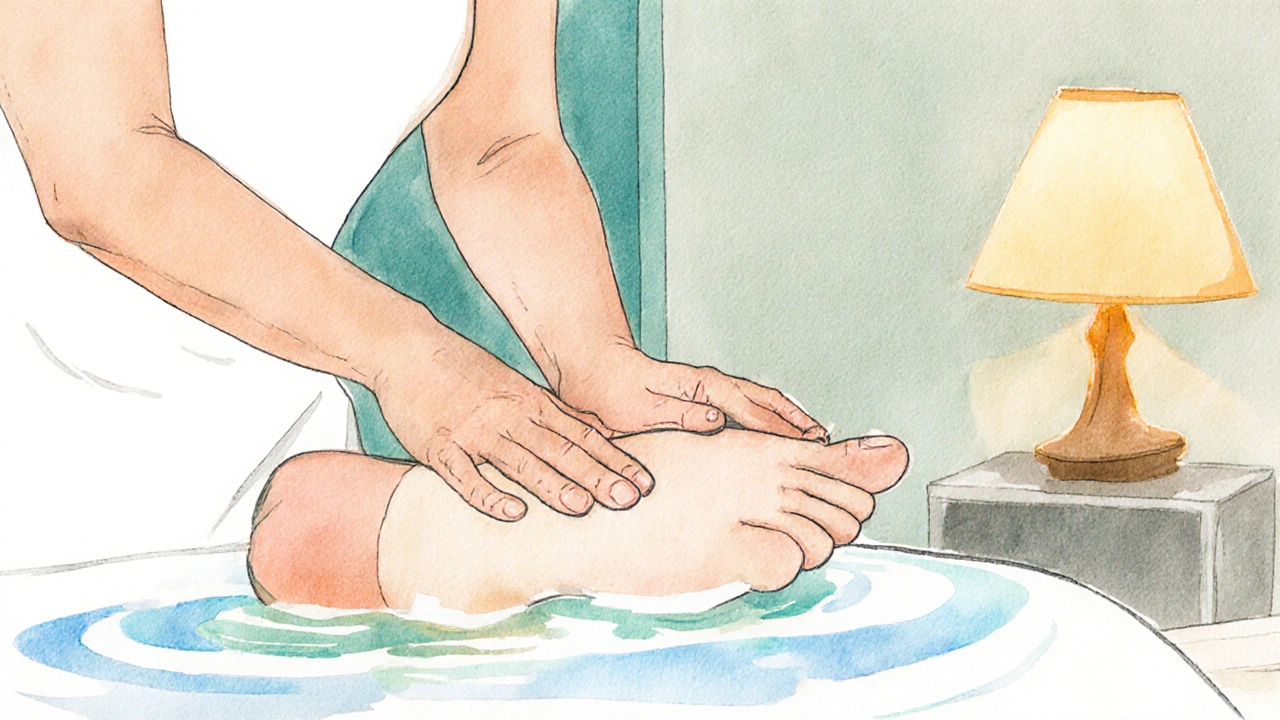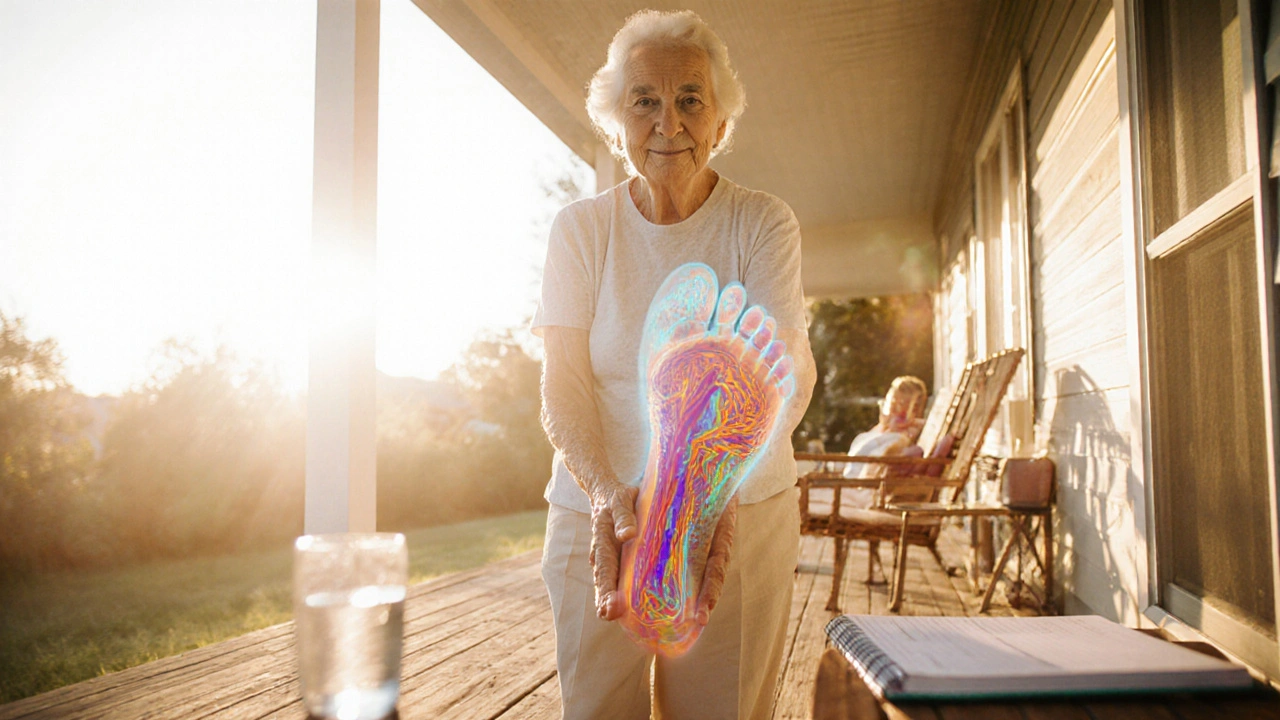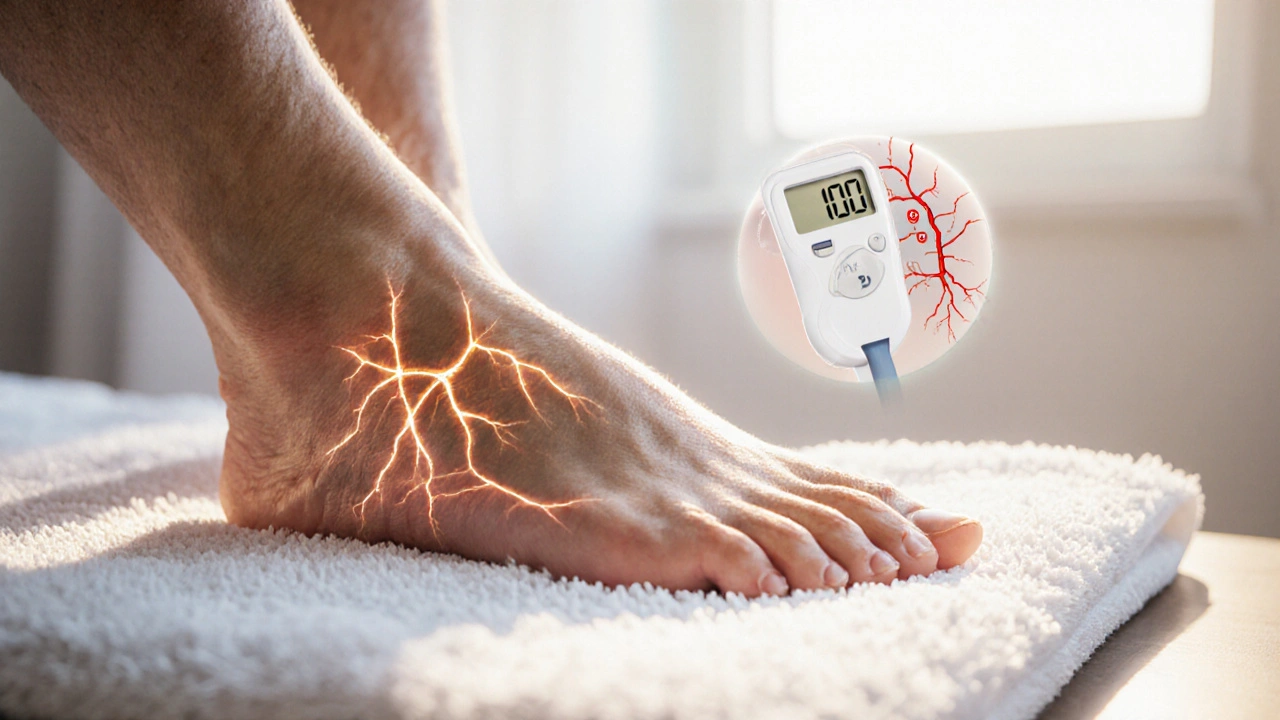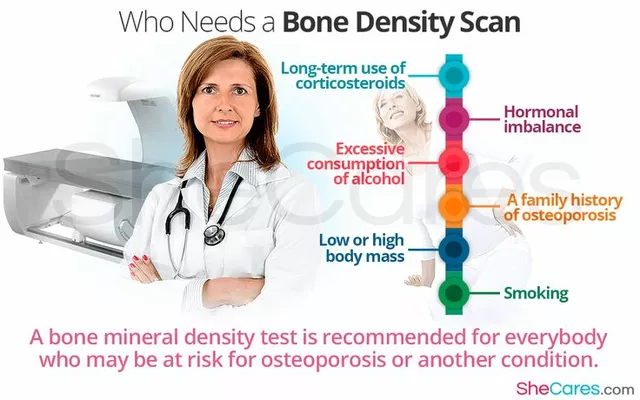DPN Massage Therapy Planner
About This Tool
This planner helps you determine the best massage therapy approach for managing diabetic peripheral neuropathy symptoms while ensuring safety and effectiveness.
Living with diabetic peripheral neuropathy (DPN) can feel like a constant battle against tingling, burning, and aching feet. While medication and blood‑sugar control are the medical backbone, many patients discover that massage therapy adds a surprisingly effective layer of relief. Below we break down why massage works, which techniques are safest, and how to fit it into a diabetes care plan.
What is Diabetic Peripheral Neuropathy?
Diabetic Peripheral Neuropathy is a nerve‑damage condition that commonly affects the feet and lower legs of people with long‑standing diabetes. It arises when high blood‑glucose levels injure the tiny blood vessels that nourish peripheral nerves, leading to reduced Nerve Function and abnormal pain signals.
Typical symptoms include numbness, tingling, shooting pain, and a heightened risk of foot ulcers because the damaged nerves can’t signal injuries effectively.
How Massage Therapy Interacts with the Body
Massage is more than a feel‑good indulgence; it triggers measurable physiological changes. When a skilled therapist applies pressure, several key processes kick in:
- Blood Circulation improves, delivering oxygen and nutrients to nerve endings.
- Mechanical stimulation prompts the release of Endorphins, the body’s natural painkillers.
- Stress hormones such as cortisol drop, which can lower perceived pain intensity and improve sleep.
- Gentle stretching of surrounding muscles eases compression on nerves, enhancing Nerve Function over time.
For patients with Diabetes Mellitus, these effects dovetail nicely with the goals of tight glycaemic control and foot health.
Massage Benefits Specific to DPN
- Pain reduction: Endorphin release and improved circulation blunt the sharp, burning sensations typical of DPN.
- Enhanced blood flow: Better perfusion supports nerve repair and reduces the risk of ulcer formation.
- Stress relief: Lower cortisol levels improve overall wellbeing, which can indirectly help blood‑sugar management.
- Improved range of motion: Loosening tight calf and foot muscles decreases mechanical pressure on nerves.
- Better sleep: Reduced nighttime pain leads to deeper rest, further stabilising glucose levels.

Massage Techniques That Work Best
| Technique | Key Benefits | Contraindications |
|---|---|---|
| Swedish (gentle) massage | Improves circulation, promotes relaxation, low pressure suitable for sensitive feet | Open wounds, severe infection |
| Lymphatic drainage | Reduces swelling, supports immune flow, helps clear metabolic waste | Deep vein thrombosis, active cancer |
| Myofascial release | Targets tight fascia around calves and ankles, eases nerve compression | Severe skin breakdown, uncontrolled hypertension |
| Gentle trigger‑point therapy | Relieves localized pain nodes, can be adapted to very light pressure | Poor wound healing, recent surgery |
Because DPN patients often have fragile skin and altered sensation, the rule of thumb is to start with low‑pressure, broad strokes (like Swedish massage) and only progress to deeper techniques if tolerated and cleared by a healthcare provider.
Getting Started: Practical Guidelines
- Find a qualified therapist: Look for practitioners certified in medical or clinical massage, and who have experience with diabetic foot care.
- Share your health status: Inform the therapist about your diabetes type, blood‑glucose range, any recent foot ulcers, and medications.
- Schedule regularly: Most studies show benefit with 1‑2 sessions per week for a 6‑8 week period, then reassess.
- Monitor blood glucose: Check your glucose levels before and after a session; some people experience a temporary dip due to relaxation.
- Foot inspection: After each massage, examine feet for redness, bruising, or new sores. Use a mirror or ask a partner to help.
- Stay hydrated: Proper fluid intake supports circulation and helps flush metabolic waste released during massage.
- Mind contraindications: Avoid massage on areas with open wounds, severe peripheral arterial disease, or uncontrolled infection.
These steps keep the experience safe while maximizing the therapeutic gains.
Integrating Massage with Overall Diabetes Management
Massage should complement-not replace-core diabetes treatments. Here’s how to weave it into your routine:
- Schedule massage on days when you have a stable blood‑sugar reading, avoiding periods of hypoglycaemia risk.
- Coordinate with your endocrinologist or podiatrist; they can advise on frequency and any needed foot‑care modifications.
- Use a foot‑care log that includes massage dates, pressure levels, and any changes in pain or sensation.
- Combine massage with gentle foot‑strengthening exercises (e.g., toe curls, ankle circles) to reinforce nerve health.
- Track pain scores using a simple 0‑10 scale before and after each session to quantify improvement.
When done systematically, many patients report a measurable drop in pain scores-often 2‑3 points on the scale-within the first month.

Potential Risks and How to Minimize Them
While generally safe, massage can pose risks for DPN patients if precautions are ignored:
- Skin breakdown: Reduced sensation may hide bruises or pressure points. Always inspect skin after sessions.
- Hypoglycaemia: Relaxation can lower blood‑sugar slightly. Keep a quick‑acting carbohydrate on hand.
- Infection: Deep tissue work on compromised skin can introduce bacteria. Ensure therapist maintains strict hygiene.
Choosing a therapist who follows strict infection‑control protocols and adjusting pressure based on your feedback are the best safeguards.
Real‑World Success Stories
Emma, a 58‑year‑old teacher from Melbourne, struggled with nightly foot burning for years. After integrating weekly Swedish massage with her insulin regimen, she noted a 40% drop in pain intensity after six weeks and fewer foot‑skin fissures. Her podiatrist confirmed improved circulation on Doppler ultrasound.
John, a 62‑year‑old retiree, combined lymphatic drainage with daily foot‑stretching. Within three months, his ulcer‑healing time shortened from three weeks to just one, allowing him to avoid hospitalisation.
These anecdotes echo growing clinical evidence that massage, when tailored to diabetic foot health, can be a powerful adjunct.
Bottom Line: Should You Try Massage Therapy?
If you’re living with diabetic peripheral neuropathy, massage offers a low‑cost, non‑pharmacologic tool that tackles pain, circulation, and stress-all factors that influence neuropathy progression. The key is to start gently, work with qualified professionals, and keep an eye on blood‑sugar and foot condition.
Frequently Asked Questions
Can massage cure diabetic neuropathy?
Massage cannot reverse nerve damage completely, but it can significantly reduce pain, improve circulation, and help prevent secondary complications like foot ulcers.
How often should I get a massage?
Most clinicians recommend 1‑2 sessions per week for the first six to eight weeks, followed by a maintenance schedule of once every two to four weeks, based on pain levels and therapist feedback.
Is there a specific type of massage that works best?
Gentle Swedish and lymphatic drainage are most commonly recommended for early‑stage DPN because they boost circulation without applying heavy pressure. Deeper techniques can be added later if tolerated.
Do I need a doctor’s referral?
A referral isn’t mandatory, but informing your endocrinologist or podiatrist ensures the massage plan aligns with your overall diabetes management and highlights any contraindications.
What should I look for in a therapist?
Choose a practitioner certified in clinical or medical massage, experienced with diabetic foot care, and who follows strict hygiene protocols. Ask about their experience with peripheral neuropathy specifically.





Andrew Irwin
October 7, 2025 AT 16:16Massage can be a solid addition to a diabetes routine, especially when neuropathy starts acting up. It’s not a miracle cure, but those gentle Swedish strokes do improve circulation, which is something our nerves really need. I’ve seen people notice a subtle drop in that burning feeling after a few weeks of consistent sessions. Just keep the therapist in the loop about any open sores and stay on top of your blood‑sugar checks.
Jen R
October 7, 2025 AT 18:13Honestly, the article nails the basics but could have dived deeper into the evidence. There are a handful of small RCTs showing a 2‑3 point drop on the pain scale after weekly Swedish massage. Also, don’t forget to mention that insurance rarely covers these sessions, so budgeting is key.
Joseph Kloss
October 7, 2025 AT 20:26One could argue that any external stimulus is a metaphor for the body’s yearning for balance. If you think about pressure as a dialogue between skin and nerve, the massage becomes a philosopher’s stone for diabetic feet.
Anna Cappelletti
October 7, 2025 AT 22:23Hey folks, just wanted to throw some optimism into the mix! Consistency is where the magic happens – even a light 30‑minute session once a week can keep the pain from creeping back. Pair it with a short foot‑stretch routine in the evenings and you’ll notice better mobility. And don’t forget to celebrate the small wins, like a night of uninterrupted sleep.
Dylan Mitchell
October 8, 2025 AT 00:20OMG the drama of a burning foot is real, but a gentle rub can feel like a lullaby for those nerves. Just don’t go full‑blitz on a wound – that’s a horror story waiting to happen.
Elle Trent
October 8, 2025 AT 02:00Building on what was said earlier, it’s crucial to match the massage intensity to the stage of neuropathy. Early‑stage patients benefit most from Swedish and lymphatic drainage, while those with moderate symptoms might tolerate light myofascial release. Always ask the therapist to avoid deep tissue on any area with reduced sensation, because you won’t feel bruising until it’s too late. And, as a side note, using a podiatrist‑approved moisturizer post‑session can keep the skin barrier intact.
Jessica Gentle
October 8, 2025 AT 03:56Massage can be a real game‑changer for people dealing with diabetic nerve pain.
First off, the gentle strokes of Swedish massage boost blood flow to the feet, which is exactly what those nerves crave.
Better circulation means more oxygen and nutrients get delivered, helping damaged fibers recover a bit faster.
On top of that, the rhythmic pressure triggers the release of endorphins, the body's built‑in painkillers.
Those endorphins not only dull the burning sensation but also improve mood, making daily glucose checks feel less like a chore.
If you have an ulcer or a broken skin area, stick to very light touch or avoid the affected spot altogether.
Lymphatic drainage is another low‑pressure technique that moves excess fluid out of the lower legs and can cut down swelling.
Some therapists also incorporate myofascial release, but only after you’ve cleared it with your podiatrist because deep pressure on compromised tissue can backfire.
Timing matters too – schedule your session when your blood sugar is stable, ideally in the mid‑range, so you don’t risk a hypoglycemic dip from the relaxation response.
Keep a quick snack handy just in case the calming effect nudges your glucose down a few points.
After each massage, do a thorough foot inspection; look for redness, bruising, or any new sores that you might have missed before.
Hydration is key – drinking water helps the lymphatic system flush out the metabolic waste that the massage releases.
Many patients report sleeping better after a week of consistent sessions, and quality sleep is another pillar of good diabetes control.
Document your pain scores before and after each visit; you’ll be surprised how quickly the numbers can drop from, say, a 7 to a 4.
Finally, keep an open line of communication with both your therapist and your healthcare team so the massage plan stays aligned with your overall treatment strategy.
Samson Tobias
October 8, 2025 AT 05:53Great rundown! I’d add that staying hydrated before a session can amplify the circulation benefits. Also, schedule your massage after a meal rather than on an empty stomach to avoid any sudden glucose drops. Keep a log and you’ll see the patterns emerge.
Alan Larkin
October 8, 2025 AT 08:06From a technical standpoint, the micro‑circulatory changes post‑massage are measurable via Doppler ultrasound – I’ve seen studies confirming a 15% increase in foot perfusion after a 30‑minute Swedish session. That’s not just anecdotal; it’s quantifiable data. For those worried about safety, the key is to avoid any deep pressure over areas marked as insensate. Also, keep the environment warm; cold rooms can cause vasoconstriction, negating the benefits. 🙂
John Chapman
October 8, 2025 AT 09:46While the perfusion numbers are interesting, one must consider the law of diminishing returns. The marginal gain from a second weekly session often pales compared to the added cost and time commitment. Moreover, clinicians stress that massage should never replace regular foot examinations by a podiatrist. It’s an adjunct, not a substitute, and that nuance gets lost in popular articles.
Tiarna Mitchell-Heath
October 8, 2025 AT 11:43Don’t forget to tell the therapist if you have any hidden wounds – they’ll blind‑spot you otherwise.
Katie Jenkins
October 8, 2025 AT 13:23Adding to that, it’s critical to audit your footwear before each session. Shoes that compress the forefoot can exacerbate neuropathic pain, counteracting any benefits from the massage itself. Also, consider a quick foot soak with Epsom salts 20 minutes prior; the warm water pre‑conditions the tissues and makes the massage more effective. Finally, keep a simple diary: date, session length, pain rating, and any skin changes. Over time, you’ll spot trends you can discuss with your clinician for a more tailored approach.
Jack Marsh
October 8, 2025 AT 15:20From a clinical perspective, the evidence base for massage in diabetic neuropathy remains modest, yet the physiological rationale is sound. Improved micro‑circulation and endogenous opioid release are well documented mechanisms. However, any protocol should be vetted by a multidisciplinary team, especially when comorbidities like peripheral arterial disease exist.
Terry Lim
October 8, 2025 AT 17:00Your blood sugar reading matters more than the massage pressure.
Cayla Orahood
October 8, 2025 AT 19:13Ever wonder why big pharma never touts massage? Because it sidesteps the profit model, yet it truly eases the fiery torment in diabetic feet. The quiet hum of a skilled therapist can feel like a secret weapon against the hidden fires that burn beneath the skin. Still, the skeptics will claim it’s all placebo, but the anecdotes keep piling up.
McKenna Baldock
October 8, 2025 AT 21:26In contemplating the nexus of touch and metabolic health, one finds that tactile stimulation serves as a conduit for homeostatic regulation. The phenomenology of pressure translates into neurochemical cascades that, when properly harnessed, may mitigate the dysregulated pathways of diabetes. Yet, such practices demand rigorous ethical oversight to ensure safety. Reflection upon patient autonomy further underscores the importance of informed consent in these interventions.
Roger Wing
October 8, 2025 AT 23:23People love hype but forget the data is thin; still massage feels good tiny benefit okay.